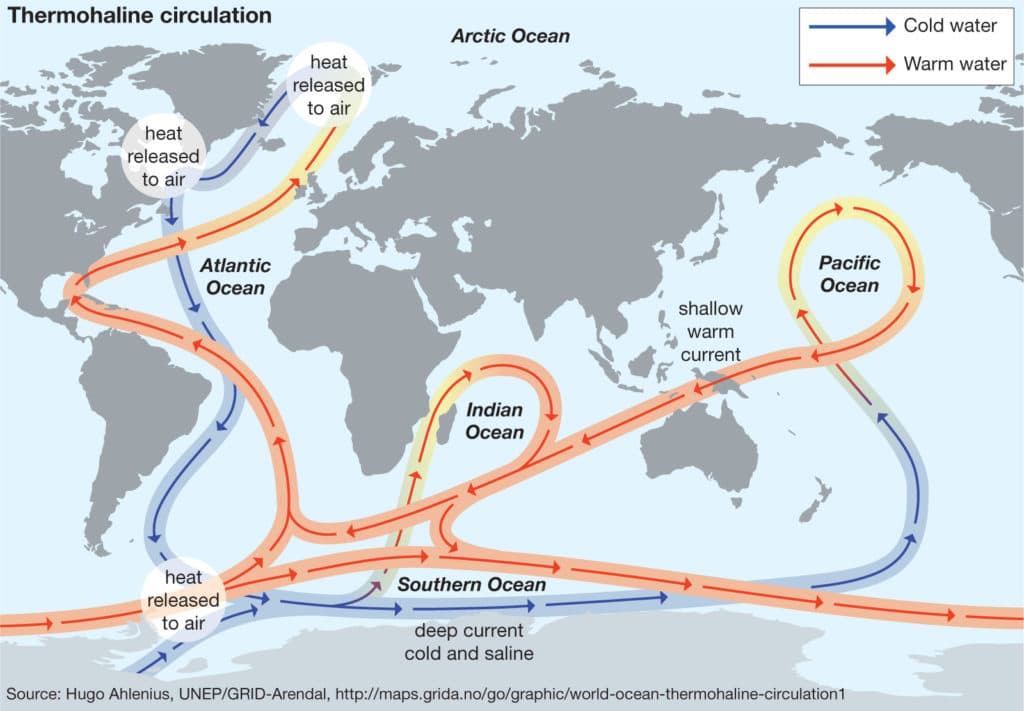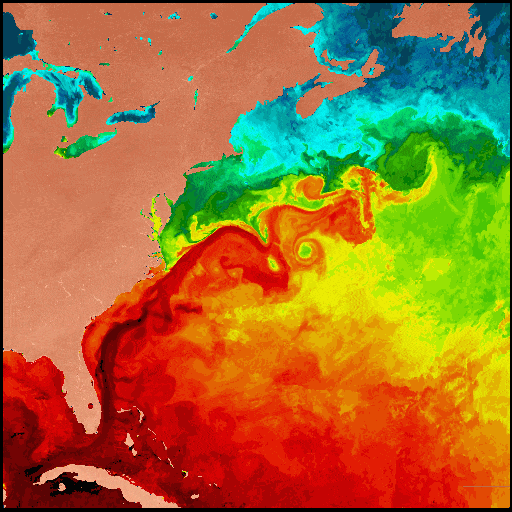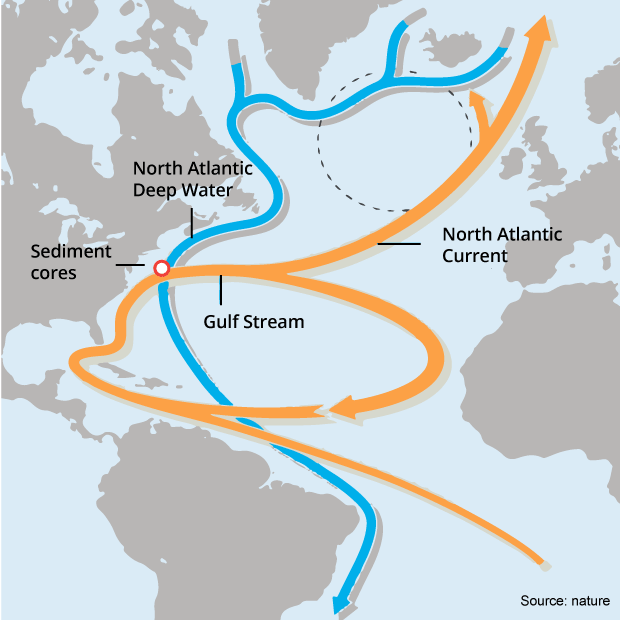The Earth’s climate is like a complex web within which every, or nearly every element interacts, either directly or indirectly. You may not have thought of this, but melting ice seems to be affecting ocean-wide currents that in turn regulate Western European weather. Here, we walk you through the relationship between climate change and the Gulf Stream.
—
On a solid icescape with no other soul for miles, the silence deafening except for the random bursts of a shrill icy wind keeping the shoulders tucked around the ears. A faint sound of a river flowing deep beneath the ice; James Balog and two crew members march what appears to be aimless across the rapidly receding frozen glacier of Greenland. Suddenly the continent of ice gives way to a massive crevasse punctuated with a single hole burrowed all but depthless, swallowing the gushing river of ice melt like some sort of giant porcelain bathtub. James, filmed by the “Chasing Ice” documentary crew, begins the treacherous descent down the crevasse. His destination: a thin snow and ice outcropping just a few meters above the water falling into the abyss. He flattens out his body almost hugging this illusion of safety praying to not hear a crack. Skull dragging his outstretched body, he dangles camera and head over the razor-thin edge; looking for that perfect shot as literal tons of ice-cold blue water roar by like continuous thunder. James is documenting the disappearance of the world’s land ice.
Through miles of lightless tunnels carved deep below the surface; the water, not unlike any other river, rushes toward the ocean. This is glacier runoff winding its way toward the ocean putting its thumb on the scale and potentially accelerating the rate of global climate change.
While there are several ways in which glacier melt is having an impact on our climate, this article focuses on its relation to the Gulf Stream… Many reading this may not know that ice melt influences the Gulf stream quite heavily, so let’s explore how this powerful ocean current came to be.
The Gulf Stream is actually one segment of the global ocean current; known as the Thermohaline cycle (THC). The THC is generated by the ocean’s temperature and saltwater density, or salinity.

Ocean water is heated at the equator due to the direct angle it receives sun radiation at those latitudes. The air is humid and saturated with moisture, along the northern coast of Brazil’s Rain Forest. As the water flows northward it dips west into the Gulf of Mexico before hugging the east coast of the Americas and heading back out to sea. This section is what we know as the Gulf Stream.

Source: NOAA.
Interestingly this ocean current generated from the edge of South America is the primary cause for those famous European Summers. How? Water takes longer to heat up than air or dry land, that’s why it can be 100°F outside but the pool is only 75-80°F. However, it also retains heat longer. The Gulf Stream essentially sunbathes and takes in all that heat along the equator and up the coastlines, and retains most of it as it ricochets out to sea and toward Western Europe. The air cools and dries, as it makes its way north; sucking moisture and heat from the ocean into the atmosphere, heating the air that the winds carry over Europe. Northern Canada, though at a similar latitude does have this luxury as there is no warm current headed toward Canada’s coastline.

The current is steadily cooling and evaporating as it migrates north. When it finally arrives off the Southern tip of Iceland the current is cold and the salinity is high because much of the water has evaporated on its long journey, leaving the salt behind. At this point, the cold dense current plunges deep into the northern ocean and begins traveling southwest, along Greenland’s coast. Here James and his crew are witnessing once mighty glaciers reduced to rivers of water now dumping into the ocean and the THC. According to NASA Greenland’s ice melt could raise the global sea level by 2 feet and has accelerated in melt rate 7 fold since 1992. That’s 234 billion tons of run-off added to the THC every year as of 2018 with projections to increase.
All of this runoff dilutes the dense saltwater in the current as it flows southward, not allowing the water to sink, causing the THC to slow down, and dissipate.
So what would it look like if the THC and with it the Gulf stream slowed dramatically or possibly even stopped entirely?
Well, Geographic and Climate Scientists may already have some idea. Nearly 11,000 years ago a similar event is believed to have happened. At the time there was a massive glacier extending from the north pole across the entirety of modern Canada and half of the United States. With changes in the earth’s climate, the glaciers began to melt and recede northward. Once it had receded to the Great Lakes on the border of the two countries the runoff was so immense it pushed its way through the landscape, broke through an ice dam, and began dumping into the ocean. With such a shift in the salinity, it triggered a collapse of the THC. This plunged Europe into a mini Ice age for 1,000 years.
If this were to happen again, it could trigger massive extinctions, famine, and the collapse of oceanic ecosystems and the fishing industry in the northern hemisphere causing major economic uncertainty. Scientists worry about whether we will have the ability to essentially jump-start the THC in the event this does happen; somehow engineering a way to pull copious amounts of freshwater out of the ocean meanwhile trying to curb greenhouse gas emissions on an even tighter timeline than previously conceived.
The THC creates oceanic upwelling: where that cold deep current eventually surfaces to begin the cycle again. Upwelling is a critical keystone in the oceans ability to capture CO2 from our atmosphere; providing “fresh” water with the capacity to absorb more CO2, than the older surface water that is mostly saturated. Without the THC we could very likely begin to see a cascading effect in our global climate. While the ocean would possibly be less acidic with the inability to absorb CO2, that would also mean more of this greenhouse gas would be in our atmosphere, thereby increasing global temperatures and increasing the melt rate of land and sea ice. With the disappearance of sea ice, we increase what’s known as dark water. Simply put, when water is in ice or snow form, it reflects heat back into space whereas its darker, liquid forms are some of the most heat absorbent surfaces on Earth.
One could write a lengthy book on the repercussions we would experience in the wake of a THC collapse, but suffice it to say it’s worth doing something about.
The good news, while surface melt is increasing, scientists believe we have some time to adapt as a global society to potentially mitigate this catastrophe; as the slowing of the THC and the Gulf Stream is a slow process.
Adaptation and mitigation is a big economic shift and investment however, it is a drop in the bucket compared to the cost of doing nothing.
To successfully navigate this challenge will need government action.
If you would like to help, reach out to your representatives; advocate for green legislation. Look for ways to get involved with environmental advocacy groups like Ocean Conservancy, Climate Action Network, Sea Shepherd, or Citizens Climate Lobby.
Knowing as much as we can about climate change, its potential effects on the planet and its inhabitants are vitally important. However, it means little if we do not act. No, one is demanding that you tie yourself to a tree or chain yourself to a bulldozer. Your advocacy can look like whatever you want it to. Consider being a sustaining donor to your favorite environmental non-profit, volunteer 2 hours a month, or a day, pick up the phone, or write a letter to your congressman, organize a march or a book club. The most important thing, DO something and don’t stop.
This article was written by Sean Porter.
You might also like: Delhi Air Pollution










![The Statistics of Biodiversity Loss [2020 WWF Report]](https://u4d2z7k9.rocketcdn.me/wp-content/uploads/2020/12/lprwinkyTHB-544x306.jpg)





